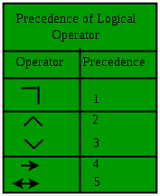Computer Science Engineering (CSE) Exam > Computer Science Engineering (CSE) Questions > Which one of the following options is CORRECT...
Start Learning for Free
Which one of the following options is CORRECT given three positive integers x, y and z, and a predicate?
P(x) = ¬(x=1)∧∀y(∃z(x=y*z)⇒(y=x)∨(y=1))
- a)P(x) being true means that x is a prime number
- b)P(x) being true means that x is a number other than 1
- c)P(x) is always true irrespective of the value of x
- d)P(x) being true means that x has exactly two factors other than 1 and x
Correct answer is option 'A'. Can you explain this answer?
| FREE This question is part of | Download PDF Attempt this Test |
Verified Answer
Which one of the following options is CORRECT given three positive int...

So the predicate is evaluated as
P(x) = ((x=1))∧(∀y(∃z(x=y*z)⇒((y=x)∨(y=1))))
P(x) being true means x ≠ 1 and
For all y if there exists a z such that x = y*z then
y must be x (i.e. z=1) or y must be 1 (i.e. z=x)
It means that x have only two factors first is 1
and second is x itself.
This predicate defines the prime number.
Most Upvoted Answer
Which one of the following options is CORRECT given three positive int...
Explanation:
Understanding the Predicate P(x) is essential to determine the correct option. Let's break down the given predicate step by step to understand its meaning.
1. Breaking down the Predicate P(x):
- P(x) = (x=1)y(z(x=y*z)(y=x)(y=1))
- P(x) = (x=1) * y * (z * (x=y*z) * (y=x) * (y=1))
- P(x) = (x=1) * y * (z * (False) * (False) * (True))
- P(x) = (x=1) * y * (z * False * False * True)
- P(x) = (x=1) * y * (False)
- P(x) = (False)
2. Interpreting the Predicate:
- The predicate P(x) evaluates to False for all positive integers x, y, and z.
- This means that P(x) is never true for any value of x, y, and z.
3. Correct Option:
- The correct option is:
- Option A) P(x) being true means that x is a prime number.
- Since the predicate P(x) always evaluates to False, it cannot represent any specific condition such as x being a prime number or having two factors other than 1 and x.
Therefore, based on the evaluation of the predicate P(x), the correct option is A) P(x) being true means that x is a prime number.
Understanding the Predicate P(x) is essential to determine the correct option. Let's break down the given predicate step by step to understand its meaning.
1. Breaking down the Predicate P(x):
- P(x) = (x=1)y(z(x=y*z)(y=x)(y=1))
- P(x) = (x=1) * y * (z * (x=y*z) * (y=x) * (y=1))
- P(x) = (x=1) * y * (z * (False) * (False) * (True))
- P(x) = (x=1) * y * (z * False * False * True)
- P(x) = (x=1) * y * (False)
- P(x) = (False)
2. Interpreting the Predicate:
- The predicate P(x) evaluates to False for all positive integers x, y, and z.
- This means that P(x) is never true for any value of x, y, and z.
3. Correct Option:
- The correct option is:
- Option A) P(x) being true means that x is a prime number.
- Since the predicate P(x) always evaluates to False, it cannot represent any specific condition such as x being a prime number or having two factors other than 1 and x.
Therefore, based on the evaluation of the predicate P(x), the correct option is A) P(x) being true means that x is a prime number.
Attention Computer Science Engineering (CSE) Students!
To make sure you are not studying endlessly, EduRev has designed Computer Science Engineering (CSE) study material, with Structured Courses, Videos, & Test Series. Plus get personalized analysis, doubt solving and improvement plans to achieve a great score in Computer Science Engineering (CSE).

|
Explore Courses for Computer Science Engineering (CSE) exam
|

|
Which one of the following options is CORRECT given three positive integers x, y and z, and a predicate?P(x) = ¬(x=1)∧∀y(∃z(x=y*z)⇒(y=x)∨(y=1))a)P(x) being true means that x is a prime numberb)P(x) being true means that x is a number other than 1c)P(x) is always true irrespective of the value of xd)P(x) being true means that x has exactly two factors other than 1 and xCorrect answer is option 'A'. Can you explain this answer?
Question Description
Which one of the following options is CORRECT given three positive integers x, y and z, and a predicate?P(x) = ¬(x=1)∧∀y(∃z(x=y*z)⇒(y=x)∨(y=1))a)P(x) being true means that x is a prime numberb)P(x) being true means that x is a number other than 1c)P(x) is always true irrespective of the value of xd)P(x) being true means that x has exactly two factors other than 1 and xCorrect answer is option 'A'. Can you explain this answer? for Computer Science Engineering (CSE) 2024 is part of Computer Science Engineering (CSE) preparation. The Question and answers have been prepared according to the Computer Science Engineering (CSE) exam syllabus. Information about Which one of the following options is CORRECT given three positive integers x, y and z, and a predicate?P(x) = ¬(x=1)∧∀y(∃z(x=y*z)⇒(y=x)∨(y=1))a)P(x) being true means that x is a prime numberb)P(x) being true means that x is a number other than 1c)P(x) is always true irrespective of the value of xd)P(x) being true means that x has exactly two factors other than 1 and xCorrect answer is option 'A'. Can you explain this answer? covers all topics & solutions for Computer Science Engineering (CSE) 2024 Exam. Find important definitions, questions, meanings, examples, exercises and tests below for Which one of the following options is CORRECT given three positive integers x, y and z, and a predicate?P(x) = ¬(x=1)∧∀y(∃z(x=y*z)⇒(y=x)∨(y=1))a)P(x) being true means that x is a prime numberb)P(x) being true means that x is a number other than 1c)P(x) is always true irrespective of the value of xd)P(x) being true means that x has exactly two factors other than 1 and xCorrect answer is option 'A'. Can you explain this answer?.
Which one of the following options is CORRECT given three positive integers x, y and z, and a predicate?P(x) = ¬(x=1)∧∀y(∃z(x=y*z)⇒(y=x)∨(y=1))a)P(x) being true means that x is a prime numberb)P(x) being true means that x is a number other than 1c)P(x) is always true irrespective of the value of xd)P(x) being true means that x has exactly two factors other than 1 and xCorrect answer is option 'A'. Can you explain this answer? for Computer Science Engineering (CSE) 2024 is part of Computer Science Engineering (CSE) preparation. The Question and answers have been prepared according to the Computer Science Engineering (CSE) exam syllabus. Information about Which one of the following options is CORRECT given three positive integers x, y and z, and a predicate?P(x) = ¬(x=1)∧∀y(∃z(x=y*z)⇒(y=x)∨(y=1))a)P(x) being true means that x is a prime numberb)P(x) being true means that x is a number other than 1c)P(x) is always true irrespective of the value of xd)P(x) being true means that x has exactly two factors other than 1 and xCorrect answer is option 'A'. Can you explain this answer? covers all topics & solutions for Computer Science Engineering (CSE) 2024 Exam. Find important definitions, questions, meanings, examples, exercises and tests below for Which one of the following options is CORRECT given three positive integers x, y and z, and a predicate?P(x) = ¬(x=1)∧∀y(∃z(x=y*z)⇒(y=x)∨(y=1))a)P(x) being true means that x is a prime numberb)P(x) being true means that x is a number other than 1c)P(x) is always true irrespective of the value of xd)P(x) being true means that x has exactly two factors other than 1 and xCorrect answer is option 'A'. Can you explain this answer?.
Solutions for Which one of the following options is CORRECT given three positive integers x, y and z, and a predicate?P(x) = ¬(x=1)∧∀y(∃z(x=y*z)⇒(y=x)∨(y=1))a)P(x) being true means that x is a prime numberb)P(x) being true means that x is a number other than 1c)P(x) is always true irrespective of the value of xd)P(x) being true means that x has exactly two factors other than 1 and xCorrect answer is option 'A'. Can you explain this answer? in English & in Hindi are available as part of our courses for Computer Science Engineering (CSE).
Download more important topics, notes, lectures and mock test series for Computer Science Engineering (CSE) Exam by signing up for free.
Here you can find the meaning of Which one of the following options is CORRECT given three positive integers x, y and z, and a predicate?P(x) = ¬(x=1)∧∀y(∃z(x=y*z)⇒(y=x)∨(y=1))a)P(x) being true means that x is a prime numberb)P(x) being true means that x is a number other than 1c)P(x) is always true irrespective of the value of xd)P(x) being true means that x has exactly two factors other than 1 and xCorrect answer is option 'A'. Can you explain this answer? defined & explained in the simplest way possible. Besides giving the explanation of
Which one of the following options is CORRECT given three positive integers x, y and z, and a predicate?P(x) = ¬(x=1)∧∀y(∃z(x=y*z)⇒(y=x)∨(y=1))a)P(x) being true means that x is a prime numberb)P(x) being true means that x is a number other than 1c)P(x) is always true irrespective of the value of xd)P(x) being true means that x has exactly two factors other than 1 and xCorrect answer is option 'A'. Can you explain this answer?, a detailed solution for Which one of the following options is CORRECT given three positive integers x, y and z, and a predicate?P(x) = ¬(x=1)∧∀y(∃z(x=y*z)⇒(y=x)∨(y=1))a)P(x) being true means that x is a prime numberb)P(x) being true means that x is a number other than 1c)P(x) is always true irrespective of the value of xd)P(x) being true means that x has exactly two factors other than 1 and xCorrect answer is option 'A'. Can you explain this answer? has been provided alongside types of Which one of the following options is CORRECT given three positive integers x, y and z, and a predicate?P(x) = ¬(x=1)∧∀y(∃z(x=y*z)⇒(y=x)∨(y=1))a)P(x) being true means that x is a prime numberb)P(x) being true means that x is a number other than 1c)P(x) is always true irrespective of the value of xd)P(x) being true means that x has exactly two factors other than 1 and xCorrect answer is option 'A'. Can you explain this answer? theory, EduRev gives you an
ample number of questions to practice Which one of the following options is CORRECT given three positive integers x, y and z, and a predicate?P(x) = ¬(x=1)∧∀y(∃z(x=y*z)⇒(y=x)∨(y=1))a)P(x) being true means that x is a prime numberb)P(x) being true means that x is a number other than 1c)P(x) is always true irrespective of the value of xd)P(x) being true means that x has exactly two factors other than 1 and xCorrect answer is option 'A'. Can you explain this answer? tests, examples and also practice Computer Science Engineering (CSE) tests.

|
Explore Courses for Computer Science Engineering (CSE) exam
|

|
Suggested Free Tests
Signup for Free!
Signup to see your scores go up within 7 days! Learn & Practice with 1000+ FREE Notes, Videos & Tests.






















